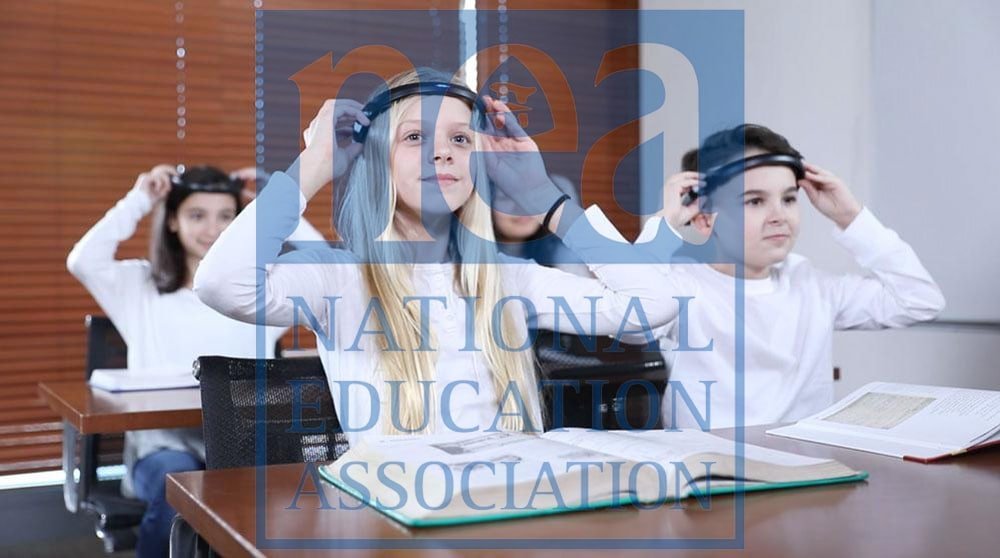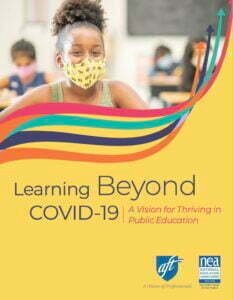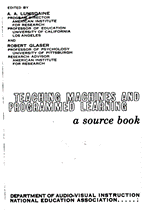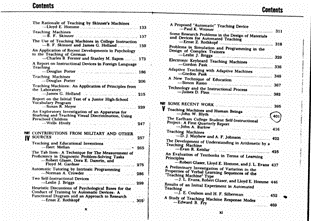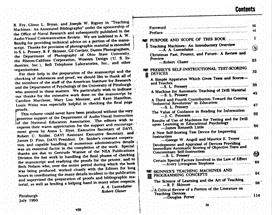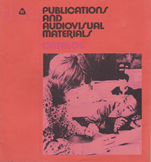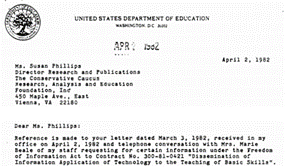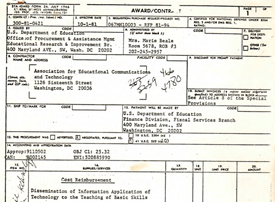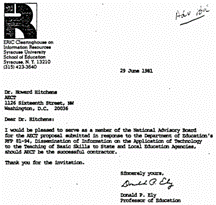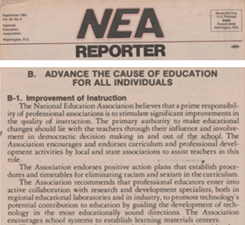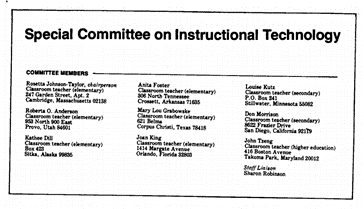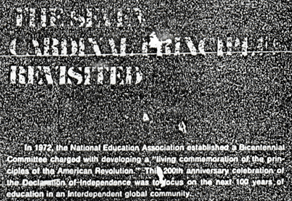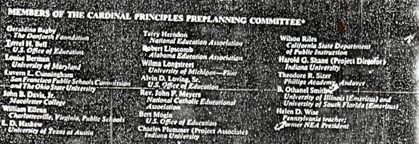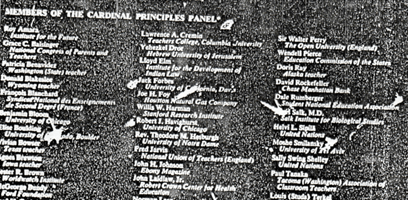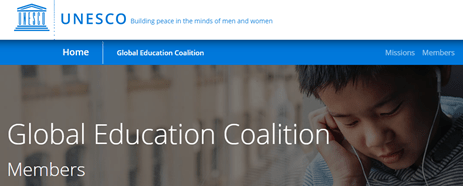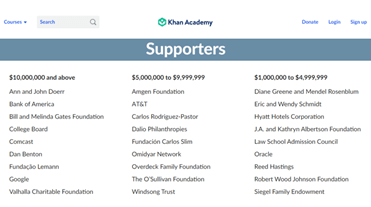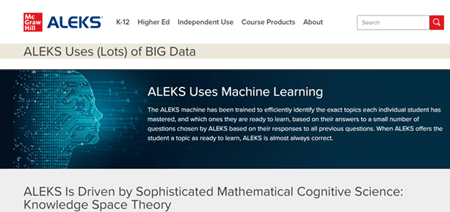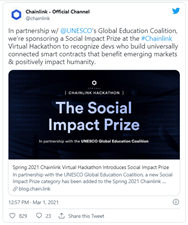For more than five years, I have been writing reports that document the dangers of the encroaching corporatization of public education through ed-tech privatization. Now, under the duress of COVID panic, public schools are rolling over to the globalist Tech Barons of the e-learning industry, just as these technocratic oligarchs of the ed-tech empire ramp up their corporate takeover of education systems. This takeover is largely occurring through public-private “distance learning” contracts that are substituting human teachers with data-mining artificial intelligence (AI) while also replacing brick-and-mortar schoolhouses with virtual classrooms online.
If you thought that teachers’ unions would fight to protect their dues-paying public educators from this techno-fascist power grab, think again. Collectively, the two largest teachers’ unions in the United States have been selling out to ed-technocracy for over a century. Without skipping a beat, the American Federation of Teachers (AFT) and the National Education Association (NEA) are now taking their ed-tech capitulation to the next level as they effectively lobby for edu-corporations. These corporations are making record profits by selling schools distance-learning technologies that are engineered to digitally track students’ psychometrics and then commercialize them via “geospatial intelligence” markets that are at the core of the Big Data-mining economy of the budding “Fourth Industrial Revolution” (4IR).
In my last article, I documented how the AFT lobbied the Centers for Disease Control (CDC) to extend COVID restrictions that perpetuate public education’s reliance on privatization from Big Tech companies, but provide questionable, if any, public health benefits. I also highlighted conflicts of interest between the AFT and the global ed-tech industry through the American Federation of Teachers’ alliances with the IBM corporation, Rockefeller philanthropies, the Trilateral Commission, and the United Nations Educational, Scientific, and Cultural Organization (UNESCO).
In this article, I will detail how the NEA cooperated with the lobbying efforts of the AFT as the two teachers’ unions tag-teamed the CDC with petitions to prolong COVID mitigation protocols that perpetuate schools’ dependence on commercial ed-tech products from multinational technology companies which have been exploiting lockdowns in order to corporatize the American education system through public-private e-learning contracts.
This article will also examine similar conflicts of interest between the National Education Association and the international ed-tech industry through the NEA’s liaisons with IBM, UNESCO, and Project BEST (Basic Education Skills through Technology), which was America’s domestic version of UNESCO’s “Study 11: New Technologies in Education,” which set up the global “information technology” (IT) infrastructure for the emerging Fourth Industrial Revolution.
Moreover, this article will also document how the NEA has been promoting a one-world education system through UNESCO’s Education for All initiative and UNESCO’s Global Education Coalition, which brings together an all-star team of Big Tech corporations that have partnered with the World Economic Forum (WEF) to usher in a techno-fascist Fourth Industrial Revolution.
Trust the Political Science
When Americans for Public Trust leaked CDC emails on May 1st, 2021, the mainstream media brought much attention to the Center for Disease Control’s correspondences with the AFT. What didn’t get much attention, however, was the CDC’s email exchanges with the NEA.
Obtained through Freedom of Information Act (FOIA) requests, these emails reveal how the NEA, along with the AFT, petitioned the CDC to roll back its school reopening guidelines. Pumping the brakes on the return to in-person learning, the NEA emails pressed the CDC to revise its school reopening provisions by issuing “clear directives” for the physical “distancing of students.” Just one month after these emails were sent, in a “Press Release” on March 19th, 2021, NEA President Becky Pringle publicly challenged the CDC’s decision to reduce “physical distancing” from “six feet” to “three feet.”
By insisting upon six-foot “distancing” between students, which would cap face-to-face classroom attendance below full capacity, the lobbying efforts of the NEA have basically pressured the CDC into relegating schools to “hybrid” curriculums that shuffle in-person classroom learning with virtual-online “distance learning,” the latter of which is outsourced to private ed-tech corporations. Apropos, shortly after petitioning the CDC to double “social distancing” requirements from three feet to six feet, the NEA teamed up with the AFT to co-author Learning Beyond COVID-19: A Vision for Thriving in Public Education, which calls for increased “access” to “devices needed for online learning” along with increased “access” to “virtual” tutoring.
The NEA states that health and safety priorities are the motivating factors for doubling down on COVID mitigation policies that effectively necessitate hybrid and remote online schooling. But ever since COVID lockdowns began, the NEA has been repeating the mantra of “follow the science,” encouraging students and teachers to trust the health and safety recommendations of CDC “experts.” So why didn’t the NEA follow the CDC science by trusting the CDC’s three-feet “social distancing” protocol? What motivated the NEA to contradict its fealty to the public health experts at the CDC by petitioning them to tighten the screws on COVID restrictions, forcing schools to rely on the for-profit ed-tech industry to provide the digital infrastructure necessary for hybrid, or “blended,” learning?
These NEA policy contradictions are even more curious when considering that, according to the Lancet, school-age youth are at low risk for COVID mortality, yet they are at high risk for cognitive, social, and emotional damages from COVID security crackdowns while mounting evidence shows that in-person schooling does not result in rising community transmission rates of SARS-CoV-2. Curiouser still, it is well known there is copious data showing that face-to-face classroom education has far more benefits for student learning than virtual distance instruction through computer screens.
So the question remains, with all these reasons for students to go back to brick-and-mortar classrooms, why didn’t the NEA “follow the science” by going along with the CDC’s school reopening recommendations? What motivated NEA bureaucrats to stump for corporate-technocratic distance learning by petitioning the CDC to clamp down on its COVID mitigation protocols for schools?
For answers to these questions, it is worth taking a closer look at the NEA’s long historical track record, which parallels the AFT’s crony capitalist history, of selling out its dues-paying teachers to the global ed-tech industrial complex by cutting side deals with Big Tech companies, such as IBM, while partnering with Education International to advance the global governance directives of UNESCO and the World Economic Forum in pursuit of the technocratic Fourth Industrial Revolution.

In light of these past dealings with communitarian corporatists and globalist technocrats, it appears that the NEA may have ulterior motives to stall the full return to in-person learning in order to wedge schools into contracting with the union’s ed-tech cronies, such as IBM, which are driving “Reimagine Education” campaigns along with UNESCO and Education International in order to spur the World Economic Forum’s Great Reset for the Fourth Industrial Revolution. By pressing the CDC to drag out COVID constraints that relegate education systems to hybrid, or blended, combinations of virtual instruction, the NEA has essentially been lobbying to permanently hitch schools to multinational ed-tech cartels that aim to data-mine cognitive-behavioral algorithms in order to psychologically condition students for “command and control” compliance in the global “Social Credit” economy of the “surveillance capitalist” Fourth Industrial Revolution.
The NEA Has Been Pushing Behaviorist Ed-Tech for Nearly a Century
For almost one hundred years, the NEA has been instrumental in driving the evolution of ed-tech from “audio-visual” (AV) technologies, such as radio and “motion picture” technologies; to “information technologies” (IT), such as computerized “teaching machines” programmed with “courseware”; to satellite technologies that link school computers together through internet telecommunications; to the current product lines of “virtual classroom” technologies, such as Google Classroom and Microsoft Teams, which teachers are being forced to use under COVID lockdown. In a nutshell, the NEA has consistently played a key historical role in transforming the one-way audio-visual transmission of instructional movies into interactive AV computer consoles linked together through satellite internet IT that facilitates distance learning through virtual classrooms which integrate behaviorist “adaptive-learning” courseware programmed to data-mine students’ psychometrics for predictive “learning analytics.”
The NEA’s love affair with ed-tech goes back as far as 1923, when the national teachers’ union set up its Division of Visual Instruction (DVI) in order “to liberate instruction from the bonds of ‘verbalism’” through mass-production of slide projectors and “motion picture” instructional technologies hyped by Thomas Edison. At the end of World War II, in 1945, the NEA’s DVI evolved into the Department of Audio-Visual Instructional Services (DAVIS), which was later renamed the Department of Audio-Visual Instruction (DAVI) in 1947, with the goal of “building better citizens of the nation and of the world by instilling desirable attitudes and appreciations thru [sic] the use of dramatic, emotionally derived learning . . . thru [sic] the use of audio-visual materials.” Stated differently, DAVI aimed to leverage movie-production technologies for the purposes of reshaping students’ “attitudes and appreciations” into new psychological states that would be compatible with world “citizenship” in a global economy.
Not long after the 1946-1953 Macy’s Cybernetics Conferences, which brought together pioneers in artificial intelligence, including John von Neumann and Norbert Weiner, the National Education Association started to shift its focus away from the one-way transmission of audio-visual ed-tech, such as radio and TV, as the NEA began to focus more on automated teaching machines that transmit interactive programmed instruction through stimulus-response algorithms. In 1960, the NEA launched a project titled “Educational Implications of Automation,” which was financed “with an unrestricted grant from IBM.” That same year, the NEA’s DAVI published a “Source Book” on “educational automation” entitled Teaching Machines and Programmed Learning, which was edited by Arthur A. Lumsdaine and Robert Glaser, who were rockstars in military psychometric testing and behaviorist ed-psych conditioning respectively:
- A. A. Lumsdaine was an army psychologist who co-authored Volume II of Studies in Social Psychology in World War II, which was prepared for a Special Committee of the Social Science Research Council of the Information and Education Division of the US Army where “cross-section studies of the entire army organization in all parts of the world” were “tested for attitudes of local and worldwide importance,” according to a 1949 issue of Social Service Review. In the “Preface” to DAVI’s Teaching Machines and Programmed Learning, Lumsdaine reports that the DAVI “Source Book” was shaped by “sponsor[ship]” from the Office of Naval Research, the Air Research and Development Command of the US Airforce, and the Human Resources Research Organization of the US Army, which specializes in “human capital management and analysis.” “Part IV” of the “Source Book” includes 125 pages of “Contributions from Military and Other Sources.”
- Robert Glaser was a prominent educational psychologist who won awards for his contributions to cognitive ed-psych, including application of the stimulus-response method of behaviorist conditioning through instructional technologies. These awards include the American Psychological Society’s James McKeen Cattell Award, which is named in honor of the Rockefeller-funded Columbia University psychology professor who combined the eugenics theories of Francis Galton with the stimulus-response method of psychological conditioning that he learned while earning his PhD from the founding father of laboratory psychology, Wilhelm Wundt. Glaser also won the E. L. Thorndike Award for Distinguished Psychological Contributions to Education, which is named after Cattell’s Rockefeller-funded protégé, whose “puzzle box” animal-training experiments served as the precursors to B. F. Skinner’s operant-conditioning methodology for programmed instruction through “Skinner box” teaching machines. “Part III” of DAVI’s Teaching Machines and Programmed Learning contains a 153-page anthology of sources expounding “Skinner’s Teaching Machines and Programming Concepts,” including three articles from Skinner himself.
It should be noted that “Part II” of the DAVI “Source Book” compiles a 57-page collection of articles examining the research of Skinner’s programmed instruction predecessor, Sydney L. Pressey, who is the founding father of teaching machines. Entitled “Pressey’s Self-Instructional Test-Scoring,” this selection of sources contains four articles from Pressey himself, including “A Third and Fourth Contribution Toward the Coming ‘Industrial Revolution’ in Education.” It should also be noted that DAVI’s Teaching Machines and Programmed Learning was shaped by “support” from the Ford Foundation along with contributions from Bell Telephone Laboratories Inc., which was part and parcel to the AT&T conglomerate.
The next year after this DAVI “Source Book” was published, DAVI produced an “AVCR supplement” titled The Role of the Computer in Future Instructional Systems, which was developed as a result of DAVI’s “Technological Development Project” (TDP) through a contract with the US Office of Education under the Department of Health, Education and Welfare (HEW). The TDP was “staffed with DAVI people,” but was managed by Donald P. Ely “under the aegis of the National Education Association.” Later, Ely would transform DAVI into the Association for Educational Communications and Technology (AECT) where he would work as a liaison with the US Department of Ed’s Project BEST, which collaborated with UNESCO “Study 11” to set up public-private partnerships between school districts and computer corporations in order to build the ed-tech IT infrastructure for the Fourth Industrial Revolution’s global system of Skinnerian programmed instruction.
During the years leading up to the debut of Project BEST’s coalition with UNESCO Study 11, the NEA advocated for the advancement of satellite technologies which would build the internet telecommunications infrastructure necessary to link together computerized teaching machines that automate operant psychological conditioning through courseware algorithms advocated by Skinner, Glaser, Lumsdaine, IBM, AT&T Bell, and the US military:
- In 1979, the NEA printed a Publications and Audiovisual Materials Catalog that includes “Educational Technology” materials, such as a book titled Computers in the Classroom and a cassette tape titled Satellite Communication: Potentials for Education, which records the “history of NEA’s involvement in satellite communications, begun in 1971.” According to the NEA Special Committee on Instructional Technology, this historical involvement can be traced back to the National Education Association’s “pioneer work” with NASA “to explore educational applications of satellite communication.”
- In 1980, the NEA published a report entitled Teachers and Public Policy: A Teacher’s Guide to Monitoring Selected Federal Education Programs, which stated, “[n]ew satellite networks open up possibilities for linking teacher centers for dissemination of teaching ideas and materials and for teacher-to-teacher interaction.”
To sum up, the NEA worked with NASA to set up satellite internet while collaborating with technology companies investing in online computer startups that would lay the groundwork for the worldwide web in order to facilitate the Fourth Industrial Revolution’s globalization of Skinner-box edu-conditioning through virtual distance learning platforms, which are currently being forced upon teachers under the pretenses of combatting COVID-19.
Presently, although the National Education Association has paid lip service to critique the “limitations” of “remote learning,” the teachers’ union has nonetheless been milking COVID lockdowns to bargain for ubiquitous school integration of the online computer-learning networks, networks which the NEA has been helping to cobble together for more than sixty years:
- On October 12th, 2020, a few months before the CDC emails, the NEA published its “Resolution Ensuring Safe and Just Schools for All Students,” which decrees that, “education technology is a tool to enhance and enrich instruction for students and access to working technology and WiFi is a necessity for students to complete assignments and access needed resources—even when not facing full-time virtual learning environments.”
- Then, on March 5th, 2021, less than a month after the CDC emails, NEA Today published an article titled “Technology Isn’t the Hero, Educators Are,” which relays a statement from the Manager of NEA Teacher Quality, Ann Coffman, who declared how,
“[d]espite the obvious deficits a year of remote learning highlighted — the decline in learning, the widening homework gap, the social isolation, the limitations of many digital tools — in many ways, there will be no going back. . . . ‘I don’t think it’s realistic that educators return to exactly what they were doing prior to the pandemic and they probably shouldn’t. . . . Some hybrid learning models can be effective.’”
- A month later, on April 15th, 2021, an NEA Today article, which is titled “How the Pandemic Will Change the Future of Schools,” forecasted how “many districts have now invested millions of dollars in distance learning infrastructure, and that means technology is likely to play a more prominent role in education, even when everyone returns to the classroom.”
Simply put, the NEA is doubling down on its long-term IT investments in the Fourth Industrial Revolution by committing to the perpetuation of the COVID ed-tech takeover, even after lockdowns are overturned and students return to in-person classroom learning where virtual e-learning is not a necessity.
Of course, the longer that the NEA can prolong emergency COVID restrictions by lobbying the CDC, the longer that schools will be forced to rely upon online virtual classrooms and digital behaviorist courseware beamed onto computer screens linked together through satellite internet IT. In any event, it is key to note here that, even if schools resume some semblance of in-person learning, the NEA is dedicated to a “new normal” in which brick-and-mortar classes are “hybridized” through “blended learning” curriculums that alternate face-to-face learning in a schoolhouse juxtaposed with digitalized remote learning on computers hooked up to the internet. To put it another way, if COVID-19 and all its variants were somehow eradicated overnight, the NEA would still insist upon the permanent adoption of 4IR ed-tech “upgrades.” Indeed, the NEA’s “Policy Statement on Digital Equity” states that “[t]he optimal learning environment should neither be totally technology free, nor should it be totally online and devoid of educator and peer interaction. The Association believes that an environment that maximizes student learning will use a ‘blended’ and/or ‘hybrid’ model situated somewhere along a continuum between these two extremes.”
In the final equation, one way or another, the National Education Association is complicit in capitalizing on COVID shutdowns in order to secure the institutionalization of blended, or hybrid, systems of virtual e-learning that will produce returns on the NEA’s investments in satellite-based ed-tech infrastructure, which the national teachers’ union has been building up for the Fourth Industrial Revolution.
NEA, AECT, Project BEST, and UNESCO Set the Stage for the 4IR
While the US Department of Education coordinated Project BEST with UNESCO Study 11 to pioneer the technocratic globalization of the Fourth Industrial Revolution, the NEA was effectively cooperating by buoying the “computer-assisted instruction” outcomes of Project BEST. In particular, the NEA reached out to US Assistant Secretary of Education, Donald Senese, to request an invitation to Secretary of Ed T. H. Bell’s National Conference on Technology and Education, which was convened to bolster the launching of Project BEST. At the same time, there is evidence that the NEA was also closely tied to Project BEST through the Association for Educational Communications and Technology, which was the main ed-tech contractor with Project BEST, which was coordinated with UNESCO Study 11 to build the e-learning IT infrastructure for the Fourth Industrial Revolution.
Upon receiving this NEA contract record, which was filed under the Department of Health and Human Services’ (HHS) “List of Contractors for FY 81 in Contractor’s Name Sequence,” Susan Phillips of The Conservative Caucus Foundation (TCCF) submitted to HHS another FOIA request “for copies of the [NEA] contract application, related correspondence and reviews.” Unable to locate the NEA contract, HHS forwarded the FOIA request to the Department of Education where Marie Beale, according to Phillips, reported that there was “no record of a grant with the National Education Association,” but that the Project BEST contract listed with the NEA was actually “a contract with the Association for Educational Communications and Technology whose address was listed as 1126 16th Street, Washington, D.C.” In a memorandum to the president of TCCF, Phillips relayed that “[n]o explanation was offered by Mrs. Beale as to why the contract awarded to AECT was listed on their printouts as having been with the National Education Association.”
So what exactly was the relationship between the AECT and the NEA at the time when the AECT signed the initial $855,282 contract to carry out the ed-tech provisions of Project BEST? According to the contract, which is dated October 1, 1981, the US Department of Education clearly identified that the AECT was operating out of its new headquarters at 1126 16th Street, which is the address listed in the Project BEST contract. So, if it was a computer glitch that caused the HHS to erroneously record the NEA headquarters at 1201 16th Street as the contractor with Project BEST, then why didn’t that glitch show up on the contract itself as well? If the Department of Ed recorded the AECT’s 1126 address on the Project BEST contract in October of 1981, then why did Nibeck reportedly state that the AECT was still “leas[ing] office space and office support staff” through the end of December, 1981?
To be sure, in 1981, only two years had passed since the Department of Education, Health, and Welfare (HEW) was restructured into two separate departments: the Department of Education and the Department of Health and Human Services. Therefore, it is possible AECT contracts were misfiled at HHS under old NEA files that were catalogued before HEW was restructured in 1979. However, recall that the AECT website states that it left the NEA offices in 1977. So, why would HEW keep the NEA and its 1201 address in the same file as the AECT for approximately two years after it was no longer located at the NEA headquarters?
No matter how you slice it, there are inconsistencies between the accounts from the AECT website, the Nibeck memorandum, the Department of Education’s Project BEST contract, and HHS’s “List of Contractors for FY 81.” Considering all of these conflicting accounts, it appears that, even after the AECT moved its headquarters just around the corner from the NEA, the two educational associations had continued close cooperation from 1977 until at least the signing of the Project BEST contract in 1981 and perhaps afterwards as well. Indeed, as the Nibeck memo reports, in 1982, the “AECT [was] still act[ing] as consultants to the NEA and serv[ing] them on committees,” which would mean that the NEA was consulting with the AECT regarding the ed-tech contracts with Project BEST.
To be sure, in 1980, the NEA produced a Teacher and Public Policy Color Filmstrip with Sound: Leader’s Guide, which lists Michael Jones of “NEA Audio-Visuals” under the “Sound Production” credits, indicating that the NEA maintained an “Audio-Visual” department at least until 1980. Furthermore, it should be noted that Donald P. Ely, who was a member the NEA, a President of DAVI, and a founder of the AECT, was also an AECT liaison with Project BEST after playing a key role in dropping DAVI’s “audiovisual label and explicitly embracing the [AECT’s] educational technology label.”
Regardless of any liaison between the National Education Association and the Association for Educational Communications and Technology, the NEA pursued its own efforts to push the regional globalization of ed-tech through Project BEST after the AECT moved its headquarters down the street. In 1981, the same year that the AECT signed the contract with Project BEST, the NEA Representative Assembly passed new “Resolutions,” which “recommend that professional educators enter into active collaboration with research and development specialists, both in regional laboratories and in industry, to promote technology’s potential contribution to education by guiding the development of technology in the most educationally sound directions.” In my recent article, “From UNESCO Study 11 to UNESCO 2050,” I document how the Department of Ed’s regional laboratories partnered with the ed-tech industry to roll out Project BEST in coordination with UNESCO Study 11’s stratagem to globalize educational IT for the Fourth Industrial Revolution.
In addition to passing “Resolutions” that facilitated the regional ed-tech planning of Project BEST, the NEA also made efforts to steer the direction of Project BEST by lobbying Assistant Secretary Senese, who oversaw the regional and international planning of BEST in coordination with UNESCO Study 11 under the aegis of Secretary Bell. On March 8, 1982, NEA Professional Development Specialist, Robert C. Snider, wrote a letter to Senese, requesting that he invite the NEA’s Director of Instruction and Professional Development, Sharon P. Robinson, to speak at the Department of Ed’s National Conference on Technology and Education, which Secretary Bell set up to jumpstart the Project BEST “Technology Initiative.”
Attached to this memorandum was the NEA Special Committee on Instructional Technology’s 1981 “Report: Presented to the 60th Representative Assembly of the National Education Association,” which recommended “[t]hat NEA establish advisory mechanisms with industry that will ensure better communications between teachers and vendors, and at the same time develop procedures to ensure a high, uniform quality of the new kinds of hardware and software that are replacing more traditional instructional materials.” This “Report” also recommended “[t]hat the NEA continue its enlightened and progressive approach to emerging relationships between new technology and human behavior.”
To be sure, this NEA Committee on Instructional Technology, which consisted of a panel of teachers led by Robinson, expressed teachers’ concerns about “problems of freedom and control,” including “the human use of human beings,” which would render teachers into “becoming subhuman cogs in a mechanistic system of instruction” that “treat[s] students like so many Pavlovian dogs, to be conditioned and programmed.” Additionally, this “Report,” which highlighted teachers’ “privacy” concerns resulting from “a system of shared information and instruction,” also declared that “[s]chool children and their teachers must not serve American industry as guinea pigs.” Nonetheless, this “Report” still entertained the possibility of a “factory-production model” of ed-tech schooling that “assign[s] cost-effectiveness to learning gains.”
Even though this “Report” from the NEA Instructional Technology Committee acknowledged teachers’ cautions against the behaviorist ed-tech industry, Robinson sang a different tune in her speech at the 1981 Banquet of the Annual Conference of the Association for the Development of Computer-Based Instructional Systems (ADCIS). In a transcript of this speech, which was attached to the NEA’s letter requesting that Senese invite Robinson to Bell’s Project BEST Teleconference, Robinson expressed her dissension from certain critics on the NEA Instructional Technology Committee as she defended
“the current resurrection—after nearly 25 years—of programmed instruction and teaching machines, which today are described—in much less threatening terms—as software, courseware, and hardware. During a recent meeting of the NEA Technology Committee, a top official of a major computer-software company dismissed the work of B. F. Skinner (and the entire operant conditioning movement of the 1950’s and 60’s) as ‘nothing more than rote learning.’ . . . This [is a] know-nothing attitude toward the past—which I’m sure is not typical of your industry’s leadership. . . . [Y]ou ain’t seen anything yet!’”
In her opening remarks to this speech, Robinson resolved that, “I hope this occasion will mark the beginning of a closer relationship between our two organizations [the NEA and the ADCIS].”
In brief, notwithstanding the National Education Association’s nod to teachers’ resistance against behaviorist ed-tech corporations, the NEA continued to carry the banner for the Skinnerian programmed-instruction industry as the national union collaborated with the ADCIS while endeavoring to cooperate with the Department of Education’s Project BEST in order to propel the NEA’s long-term investments in automated teaching machines and satellite technologies that link together e-learning computers through internet IT.
These connections between the NEA, the AECT, and Project BEST are important to highlight because Project BEST was America’s domestic version of UNESCO, which was commissioned to partner with multinational technology corporations, such as Microsoft, Apple, and IBM, in order to propagate global IT infrastructure through public-private ed-tech partnerships that would pave the way for the Fourth Industrial Revolution. Considering that the National Education Association, while maintaining close ties to the AECT, continued to stump for the education technology industry by lobbying Project BEST, which was coordinated with UNESCO Study 11, it follows that the NEA would have a stake in leveraging COVID restrictions to mandate ed-tech corporatization geared for the Fourth Industrial Revolution. By petitioning the CDC to clamp down on COVID regulations requiring schools to facilitate hybrid systems of virtual distance learning, the NEA is effectively hedging schools into public-private partnerships with Big Tech companies, including Study 11 participants such as Microsoft, Apple, and IBM, all of which are members of the World Economic Forum, which is spearheading the Great Reset for the Fourth Industrial Revolution.

Staying the course toward a techno-fascist Fourth Industrial Revolution, a couple months after the National Education Association exchanged emails with the CDC, the NEA’s “Demands for Safe and Just In-Person Learning” insisted upon “[h]ybrid delivery of instruction” through “split scheduling for schools to ensure smaller class sizes and social distancing” by shuffling students back and forth between in-person classroom learning at schoolhouses and virtual online learning at home. In addition, the NEA demanded that schools “[c]lose the technological gap by providing as many devices as possible to all students” while “[p]rovid[ing] expanded access to broadband and technology to close the ‘digital divide.’”
Committed to these demands, the NEA is jockeying to keep the lane open for Big Tech corporations, such as Microsoft, Apple, and IBM, to put the finishing touches on UNESCO Study 11’s groundwork for the burgeoning Fourth Industrial Revolution in education.
UNESCO, EI, and the NEA’s Global Cardinal Principles: Building a One-World Schoolhouse
In addition to collaborating with IBM, AT&T, and NASA to construct the ed-tech infrastructure for the Fourth Industrial Revolution, the NEA has likewise driven the multinational dissemination of 4IR education technologies through alliances with UNESCO and other world governance institutions, such as the Education International (EI) union, along with globalist oligarchs, such as David Rockefeller and members of the Order of Skull and Bones.
While the international objectives of UNESCO Study 11 were being deployed regionally across the United States through Project BEST, the President of the NEA was Mary H. Futrell, who would go on to sit on the Board of Directors of K12 Inc.: the international virtual charter school corporation that was set up by US Secretary of Education, William Bennett, after he took over Project BEST from Secretary of Ed, Terrel H. Bell. After stepping down from the NEA presidency, Futrell would become a Member of the US National Commission for UNESCO, and she would also be appointed as the President of Americans for UNESCO.
Similarly, after her reign as the President of the World Confederation of Organizations of the Teaching Professions (WCOTP), Futrell would become the founding President of Education International, which dissolved and assimilated the WCOTP and the International Federation of Free Teachers’ Unions to form the world’s largest international teachers’ union as it combines “some 240 national educator unions and associations,” including the NEA and the AFT. In addition, Futrell has served as the Co-Director of the Center for Curriculum, Standards, and Technology, and she has also sat on the Board of Directors of the International Council on Education for Teaching; the Carnegie Foundation for the Advancement of Teaching; and the Kettering Foundation; the latter of which teamed up with the Rockefeller Foundation and the US Office of Education to fund the John Goodlad Study, which produced a pivotal series of “community schooling” handbooks, including Schooling for a Global Age.
Goodlad’s community-schooling protocols, which include stipulations for computerized ed-tech innovations, were implemented by Theodore R. Sizer, who was a member of the 1976 Cardinal Principles Preplanning Committee of the NEA’s Bicentennial Committee. Sizer set up the Coalition for Essential Schools where Linda Darling-Hammond became a member of the Executive Board. Darling-Hammond, who has been an advisor to both President Obama and President Biden, is the President and CEO of the Learning Policy Institute, which is campaigning to “Strengthen Distance and Blended Learning” with the help of funding from the Hewlett Foundation: the tax-exempt arm of the Hewlett Packard computer corporation, which is a member of the World Economic Forum.
Also on the NEA’s Cardinal Principles Preplanning Committee was Secretary of Education, T. H. Bell, who oversaw Project BEST. This Bicentennial Committee was commissioned by the NEA to commemorate the 200th anniversary of the Declaration of Independence by ironically developing a “global curriculum” of “[n]eoacademic skills,” including “use of computer languages,” that would redesign “the next 100 years of education in an interdependent global community.” To help establish this international education system for a technocratic world order, the NEA’s Cardinal Principles Panel appointed corporate-globalist, David Rockefeller: a Council on Foreign Relations (CFR) member who helped to co-found the world governance bodies of the Trilateral Commission, the Bilderberg Group, and the Club of Rome. It is worth noting here that the former Executive Director of the NEA, Corina Cortez, is now the Senior Vice President of Strategic Opportunities at the Rockefeller Foundation.
Another member of the NEA’s Cardinal Principles Panel was Skull-and-Bonesman McGeorge Bundy, who was the Dean of the Graduate School of Education at Harvard University where he funded B. F. Skinner’s “teaching machine” research, which was published in Skinner’s book, The Technology of Teaching. At the time of Bundy’s appointment to the NEA Panel, he was the President of the Ford Foundation where he worked with another Bonesman, Harold Howe II, who was the Vice President of the Ford Foundation and a former Commissioner of Education under US President Lyndon Baines Johnson. It is worth noting here that David Rockefeller’s uncle, Percy Rockefeller, was also a member of the Order of Skull and Bones: the infamous Yale University secret society which has been steering the evolution of laboratory ed-psych into corporate ed-tech for more than a century. It is also worth noting that Bonesman Archibald MacLeish sat on the Governing Board of UNESCO where he wrote the Preamble to the UNESCO Constitution.
Building on the NEA’s Cardinal Principles for an “interdependent global community” of schools in a one-world education system, the National Education Association took up the mantle of UNESCO’s 1990 World Conference on Education for All, which was convened in collaboration with the World Bank. Through a 1991 follow-up conference hosted by the United State Coalition for Education for All (USCEFA), the NEA teamed up with IBM, Apple, the US Department of Education, and USAID to sponsor UNESCO’s Education for All initiative by participating in the USCEFA Conference, which issued a “Report” titled Learning for All: Bridging Domestic and International Education.
In sum, despite the National Education Association paying lip service to the local concerns of its dues-paying teachers in the United States, the NEA’s actions demonstrate a long track record of the union’s bureaucratic commitment to building the technocratic “School World Order” blueprinted by corporate foundations and ed-tech companies in bed with world governance institutions, such as UNESCO and the WEF. From NEA President Futrell’s leadership at UNESCO, K12 Inc., the Kettering Foundation, and the Carnegie Foundation for the Advancement of Teaching; to the NEA’s Cardinal Principles partnerships with David Rockefeller at Chase Bank, Bonesman McGeorge Bundy at the Ford Foundation, and Reagan’s Secretary of Ed, T. H. Bell, who helmed Project BEST; all the way to the NEA’s endorsement of UNESCO’s Education for All; it appears that the NEA’s real constituents are not the dues-paying teachers whom the union purportedly represents. Rather, based on the National Education Association’s long history of alliances with world governance bodies, multinational ed-tech companies, and international corporate foundations, it is evident that the NEA’s real constituents are the globalist oligarchs and technocrats who have been steering humanity into a one-world “Singularity” driven by a post-human Fourth Industrial Revolution.
The NEA Brings UNESCO’s Global Education Coalition to a Computer Near You
Fast-forward to the present COVID era, and the NEA is endorsing UNESCO’s Global Education Coalition. On the National Education Association’s online “Resource Library,” the NEA’s International Relations division posted a “Toolkit” link to the UNESCO Global Education Coalition’s “wealthy information on the impact of COVID-19 pandemic on schools,” including resources for “continuing to learn during the lockdown.” By posting a portal to the Global Education Coalition’s “distance learning” resources, the NEA is funneling students and teachers into UNESCO’s international network of public-private partnerships between Big Tech companies, tax-exempt corporate foundations, world governance institutions, and globalist non-governmental organizations (NGOs).
At the top of the list, members of UNESCO’s Global Education Coalition include Big Tech corporations, such as IBM, Google, Microsoft, Salesforce, Huawei, Verizon, Facebook, Zoom, and Qualcomm, all of which are also members of the World Economic Forum. At the same time, UNESCO’s Global Education Coalition also includes globalist NGOs and world governance institutions, such as the OECD, the International Society for Technology in Education, the International Council for Open and Distance Education, Videogames without Borders, the International Labour Organization, and the International Education Funders Group. Simultaneously, the UNESCO Global Education Coalition also includes the following ed-tech companies:
Khan Academy: A virtual online-learning platform that provides “adaptive learning” courseware, which is the modern digital version of Skinner’s analogue teaching machines. Khan Academy, which also promotes “virtual reality” ed-tech, is funded by tens of millions of dollars from telecommunications companies, including AT&T and Comcast, and Big Media corporations, such as the Walt Disney Company. Khan Academy is also bankrolled by Netflix Founder and CEO, Reed Hastings, who is a proponent of replacing elected public school boards with the “self-perpetuating governance” of public-private charter school corporations. Additionally, Khan Academy is financed by Big Data companies, such as Oracle and Google. At the same time, Khan Academy is bankrolled by Jack Dorsey, who is the Founder and CEO of Twitter, and Bilderberger Eric Schmidt, who is a former Google CEO and a current Technical Advisor at Alphabet, which is Google’s parent company. Other Khan Academy funders include Bank of America; the Carnegie Corporation of New York; the Bill and Melinda Gates Foundation; the Elon Musk Foundation; the Silicon Valley Community Foundation; the Walton Family Foundation; the Robert Wood Johnson Foundation; and the Heinz Family Foundation.
Blackboard Inc.: A “learning management system” (LMS) that aggregates students’ learning analytics from various dashboard modules and applications, including McGraw Hill’s adaptive-learning “Connect” app. Blackboard partners with Amazon Web Services, Google, Microsoft, LinkedIn, Sharp, Adobe, Dropbox, Pearson, Cengage Learning, Macmillan Learning, Hawkes Learning, ALEKS, and Biometric Signature ID.
McGraw Hill: An educational publishing and technology corporation that supports innovations in “virtual reality” (VR), “augmented reality” (AR), and “extended reality” (XR) ed-tech, such as Facebook’s Oculus and Google’s “Cardboard.” In addition, McGraw Hill facilitates adaptive-learning apps, including Connect and ALEKS (Assessment and Learning in Knowledge Spaces). McGraw Hill also partners with Clever, which is another adaptive-learning software company that has been funded by Bilderberger Peter Thiel.
- Technovation: A “global tech education nonprofit” that seeks to “Demystify AI in the Classroom” in order to integrate “AI, Machine Learning, and Data Science” into “curriculum[s] at the K-12 level.” Technovation’s Board of Directors includes members of Salesforce; Google; Reddit; the UK Government Office for Artificial Intelligence; the World Bank Group; and the Roblox videogame company. Additionally, Technovation’s AI Education Committee seats affiliates from IBM; Google; the University of Michigan AI Laboratory; the Center for AI in Society; the Royal Institute of Technology’s Department of Robotics, Perception and Learning; and the Broad Institute of Harvard and the Massachusetts Institute of Technology.
- Virtual Educa: A “multilateral cooperation initiative” that is “committed to the . . . development of . . . contemporary educational technology.” In pursuit of ed-tech innovation, “Virtual Educa operates through an alliance of international institutions, multilateral agencies and public and private entities, bringing together the public, business, academic and civil society sectors.” These alliances include “linkages” and “partnerships” with the World Bank, the Inter-American Development Bank, the Organization for Economic Cooperation and Development (OECD), Microsoft, Intel, Hewlett Packard, Pearson, Desire2Learn, Blackboard, Qualcomm, Lego Education, and Britannica Digital Learning.
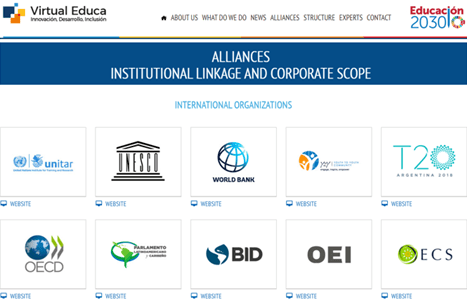
- EdTech Hub: A “global non-profit research partnership” that hosts a database of “EdTechTools” in order to guide “policymakers” and “governments” in their “decisions about technology in education.” EdTech Hub’s suite of EdTechTools “was designed to help decision makers at all levels in the global education and training community find resources that facilitate and support remote learning.” This directory of EdTechTools lists ClassDojo, Coursera, Edmodo, Facebook Get Digital, FutureLearn, Google Classroom, Khan Academy, LinkedIn Learning, Microsoft Learn, Moodle, IBM’s Open P-TECH, and Schoology, which is a subsidiary of Power Schools, which platforms educational data-mining companies that track biometric student ID and “precrime” analytics. EdTech Hub partners with the World Bank and the Gates Foundation.
- Sesame Workshop: The “non-profit media and educational organization behind [the] Sesame Street . . . television show.” Sesame Workshop partners with IBM’s Watson Education AI, which conditions students with cognitive-behavioral adaptive-learning algorithms and other “predictive learning” analytics. Project BEST documents cite Sesame Street’s audio-visual educational materials as the technological precursors to the “microcomputer” ed-tech that was globally deployed through UNESCO Study 11.
The website for UNESCO’s Global Education Coalition also includes an online hub for “[d]istance learning solutions and recommendations,” which link to several of these bulleted ed-tech platforms and products. In addition, this UNESCO directory for distance-learning ed-tech provides links to Nearpod and KitKit School. Nearpod ed-tech, which is bankrolled by Salesforce CEO Marc Benioff, who is a CFR member and a WEF Trustee, caters “personalized” lessons through “adaptive learning” software and “virtual reality” programs that capitalize on “[u]p and coming trends in BYOD (bring your own device [to class]),” according to the Nearpod Blog. KitKit School, financed by Elon Musk in partnership with UNESCO, engineers “independent-learning” technology that digitalizes lessons through “a game-based core and flexible learning architecture,” which can adapt to students’ competency levels “irrespective of their knowledge, skill, and environment.”
To put the cherry on top, the UNESCO Global Education Coalition also partners with Chainlink, which provides “middleware” technology engineered to funnel “off-chain” data, such as students’ learning analytics, onto blockchain and other “distributed ledger technologies” (DLTs) through the internet-of-things (IoT) and the internet-of-bodies (IoB). In a December 2020 article for the Activist Post, I documented how Chainlink will be instrumental in building the internet-of-everything infrastructure necessary for a “Social Credit” surveillance panopticon that digitally dictates citizens’ access to public and private services, including education, employment, healthcare, housing, transportation, due process, and even food, based on a person’s biopsychosocial algorithms, such as psychometric data from adaptive-learning courseware. More recently, in my last Unlimited Hangout article, I documented how Chainlink is partnering with UNESCO to facilitate “social impact” investments for “IoT-based projects that leverage Chainlink External Adapters to connect smart contracts to real-world sensors and automate outdated, paper-based processes” by digitizing compliance records, such as “[e]ducational certificates,” so that they can be electronically “recorded on-chain and in universal passports.”
To put it all together, the NEA’s endorsement of the UNESCO Global Education Coalition illustrates how the National Education Association is on board with the Fourth Industrial Ed-Tech Revolution, which is being steered by a cartel of Big Tech corporations that are in bed with the United Nations and the World Economic Forum and colluding to install a one-world Social Credit system that data-mines students’ biometrics and psychometrics. This data, harvested from children and youths, is destined for use in “human capital management” as an integral part of a public-private “surveillance capitalist” economy. To be sure, by lobbying the CDC to reduce COVID physical distancing from six feet to three feet, the NEA effectively pressed for policies that would force the American education system to continue privatizing public schools with adaptive-learning AI that has been engineered to data-mine students’ psychometrics for “predictive analytics” as well as programmed to technocratically manage the Social Credit economy of the Fourth Industrial Revolution.
The NEA Cannot Serve Two Masters
In closing, the history of the NEA has been shaped, time after time, by behaviorist technocrats, such B. F. Skinner; telecom corporations, including AT&T; government agencies, like NASA; Big Tech corporations, such as IBM; and world governance institutions, including UNESCO. From the seminal research and development of stimulus-response teaching machines; to the rollout of international satellite IT that connects adaptive-learning courseware through internet telecommunications; to the establishment of global curriculums for a one-world education system governed by UNESCO; all the way to the multinational proliferation of public-private ed-tech markets streamlined by UNESCO Study 11 and the UNESCO Global Education Coalition—the NEA has been steadily marching in lockstep with the United Nations’ and the World Economic Forum’s mission to usher in a techno-fascist Fourth Industrial Revolution.
If you were perplexed by the fact that the NEA lobbied the CDC to encumber its back-to-school guidelines with tighter COVID restrictions, which perpetuate distance learning curriculums facilitated through public-private contracts with Big Tech corporations, it might make more sense now. It seems more than just plausible that the National Education Association has ulterior motives rooted in their long history of collusion with Skinnerian technocrats, IBM corporatists, US government bureaucrats, and UNESCO globalists in order to bring about what is now most often referred to as the Fourth Industrial Revolution.
Endnote:
To read the entirety of Project BEST and UNESCO Study 11 along with other related documents from the NEA, the AECT, and the US Department of Education, subscribe to my web-brain database at my website: schoolworldorder.info




